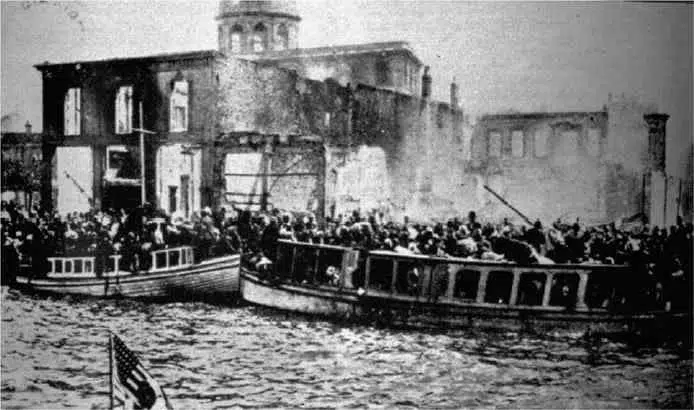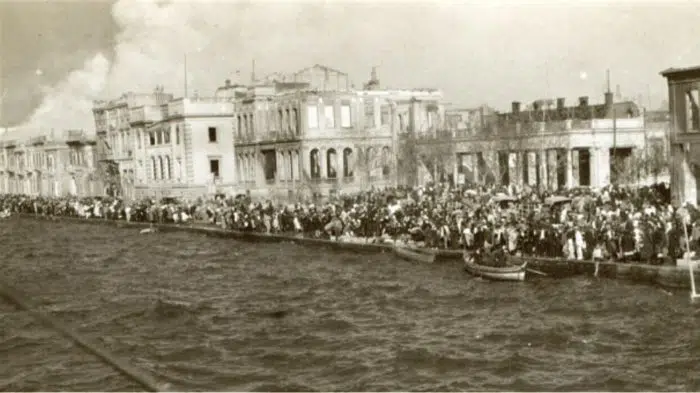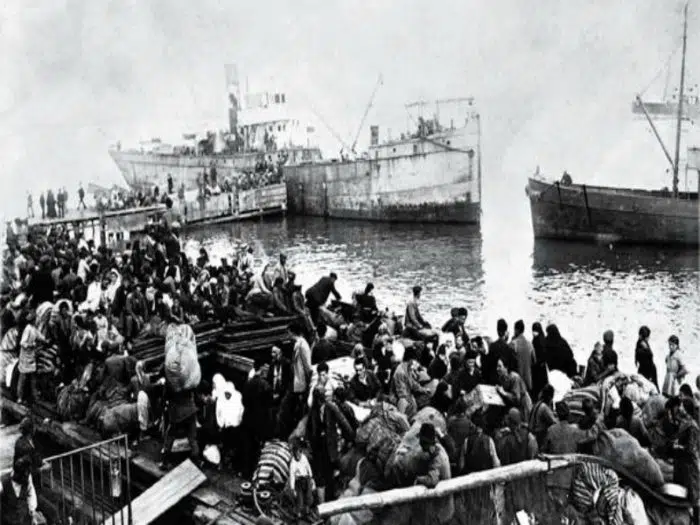
September 13, 1922 marks one of the darkest days of Hellenism, as Smyrna, one of the most prosperous and beautiful cities on the Mediterranean coast of Asia Minor, was destroyed by the Turks, sending hundreds of thousands of Greeks to a homeland they had never known.
Only five days before the Smyrna destruction, the Greek Army, which had come to Asia Minor to liberate lands that once were Greek left, defeated by Turkish troops under the leadership of the founder of the new nation, Kemal Ataturk.
Once the Greek Army had retreated, the Turkish troops entered the city from the west side of the beach that stretched the entire length of the city; in a short time, they had placed themselves along its entire length to its end, or Punta (otherwise known as Alsancak), an area that extended to the northern end of the waterfront where only ethnic Greeks lived.
At the time, the city of Smyrna was predominantly Greek, with forty-five percent of its population belonging to that ethnic group. The Turks who lived there were actually the minority, comprising only twenty-three percent of the population. There were also strong Armenian and Jewish communities in the city, known for their thriving commercial trade.
Kemal Ataturk, the leader of the Turkish troops, was a firebrand who made it known that he wanted to be called the founder of “New Islam.” It was ironic, however, that he had actually been born in Greece in the ancient city of Thessaloniki, and in previous years, he had pretended that Greece was his friend.
In fact, he had visited Athens with great ceremony and had even attended a theatrical performance starring the well-known actress of the time, Zozo Dalmas, with whom he began a relationship—later taking her back to the Dolmabahce Palace in Istanbul.
Initially, the locals, mostly Greek Christians, Armenians, and Jews, believed that the invading Turkish soldiers would be kept in order by the Allied Navy, comprised of the American, British, and French ships anchored off the port, so they were not overly concerned. The allied ships, bobbing there in the waters just off the city were a guarantee of their safety, they thought.
However, the Americans had had to accept an enforced neutrality, and they were legally prohibited from taking any part in political events of that area.
The end of peace
The peace that had reigned there was soon to be broken forever, and the events took place at breakneck speed. Within hours, Turkish soldiers, for no apparent reason, began to act with violence against Armenian merchants along the coast, destroying and looting their shops.
Seeing the commotion, the captain of an American ship disembarked and asked the Turkish soldiers what they were doing. They replied that they had orders to expel Armenians from the city. The American captain then simply turned around and returned to his ship, not wanting to oppose Ataturk’s orders.

It was just the Armenians at first. Yet, the following day, eyewitnesses from the American Institute saw Turkish soldiers throwing lighted torches and pouring cans of gasoline indiscriminately into homes in the Paradise area of the city, where the mansions of wealthy Greeks and Armenians stood.
In the end, the only neighborhood that remained untouched by the arsonists was that of the Turks.
That same night, the horrified residents left their torched houses. The order from above was that they should remove themselves by any means possible and empty Smyrna completely. Carrying very few belongings, Greeks flocked to the port, some to the ships, others to the Paradise area to find refuge in foreign schools, clubs, and consulates.
By that night, the entire city had surrendered to the blazes set by the Turks. Angry, orange flames lit up the remaining buildings in the once beautiful city while smoke made it impossible to breathe.
The ornate waterfront buildings were burning, shops were shrouded in flames, and Alsancak Beach was engulfed in black sheets of smoke while people crowded onto the docks trying desperately to embark on any ship that would take them away from the inferno.
The Allied sailors and soldiers watched the Turkish troops unleash their hate on the non-Turkish residents, but did nothing to intervene in the atrocity. Thousands of people had gathered at the port, leaning for support against the belongings they managed to carry with them.
Terrified, exhausted, and helpless, they watched with the fear of death in their eyes the city they had built being completely destroyed by the barbaric invaders. They knew that those who stayed behind would surely die.
Smyrna, a ghost town
During the two nights of September 12th and September 13th, the once beautiful city became a flaming ghost. The once prosperous and happy citizens would have to seek refuge in the land of their ancestors. Some even went to the Americas after deciding to start their lives over again there.
Once natives of lands where their ancestors had lived since time immemorial, they were the horrified witnesses to the second arrival of conquerors in the long history of Asia Minor.
Crowded into boats and dinghies, they tried to reach the approaching ships that would take them away from the inferno, attempting to get as far away as humanly possible from the horror of the port.
Some made it. Many others were pushed back into the sea for fear that the boat they managed to climb onto would sink from the excessive weight.

The day after the initial fire, Patriarch Chrysostomos, the head of all the Greek Orthodox faithful around the world, was hanged by Turkish soldiers after being brutally tortured. The atrocities had no end until the destruction of Smyrna was complete.
The civilian Turks of the city joined the troops in destroying whatever shred of Hellenistic civilization was left.
Today, very few of the baroque buildings on Alsancak Beach remain standing to remind visitors of the grandeur of a long-lost past. In the city’s interior around the old Smyrna, there are only a few buildings that survive of that time, with architectural elements that are echoes of the majestic buildings which once stood along the waterfront.
See all the latest news from Greece and the world at Greekreporter.com. Contact our newsroom to report an update or send your story, photos and videos. Follow GR on Google News and subscribe here to our daily email!



